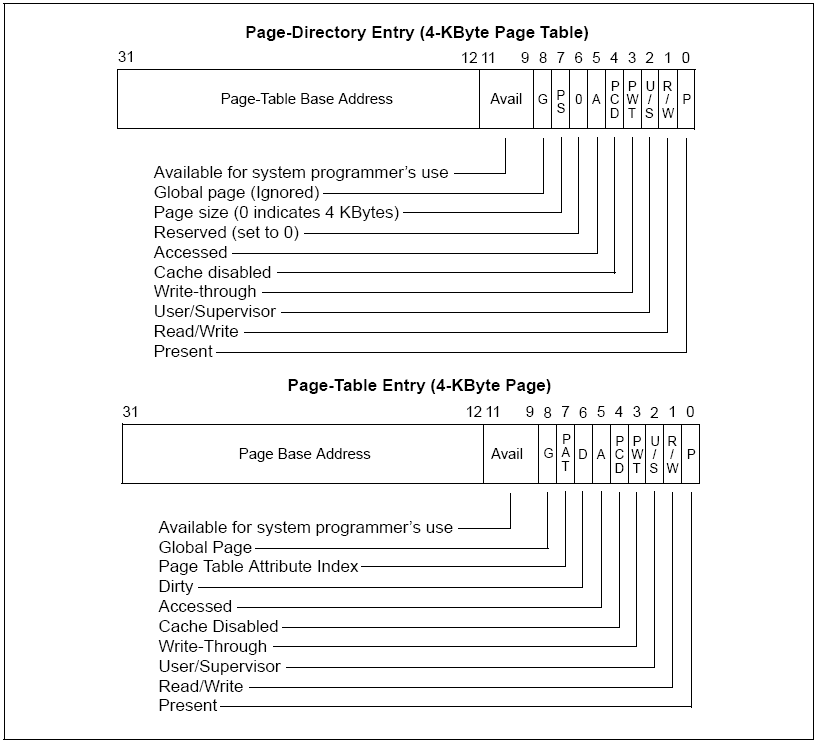It’s the time, to 64 bit.
We didn’t enable paging and define data structure because 32bit protection mode is before IA-32e mode.
Anyway, We need to define a data structure for memory paging function.
There are two methods exist.
First one is 4-step-paging that would slice memory every 2MB.
The second one is 5-step-paging that would slice memory every 4KB.
In this picture describe 5-step-paging using 4KB, but I’ll use 4-step-paging using 2MB.
No PT.

One of entry in Page Directory Table.
512 2MB Entries can be stored in this Table.
That means each directory can be present 512 * 2MB = 1GB.
We need the 64-page directory point because we will support 64GB.
So We need only one entry in PML4 table.
Shortly, Securing memory area is PML4 table, Page Directory Point Table and Page Directory Table.
In source code that was named PMl4, PDPT, and PD.
Also, BITFLAG was supported because A lot of Flags has existed that would be overlapped.
Following is Memory assign size for this data structure.
512 8byte of PML4 Entry would use 512 * 8byte.
512 8byte of PDPT Entry would use 512 * 8byte.
512 8byte of PD Entry would use 512 * 64 (support 64GB).
So We need 264KB.
We’ll assign 64-bit kernel to 2MB area, so let’s store to 1~2MB area.
#ifndef __PAGE_H__
#define __PAGE_H__
#include "Types.h"
#define PAGE_FLAG_P 0x00000001
#define PAGE_FLAG_RW 0x00000002
#define PAGE_FLAG_US 0x00000004
#define PAGE_FLAG_PWT 0x00000008
#define PAGE_FLAG_PCD 0x00000010
#define PAGE_FLAG_A 0x00000020
#define PAGE_FLAG_D 0x00000040
#define PAGE_FLAG_PS 0x00000080
#define PAGE_FLAG_G 0x00000100
#define PAGE_FLAG_PAT 0x00001000
#define PAGE_FLAG_EXB 0x80000000
#define PAGE_FLAG_DEFAULT (PAGE_FLAG_P | PAGE_FLAG_RW)
#define PAGE_TABLE_SIZE 0x1000 //4KB
#define PAGE_DEFAULT_SIZE 0X200000
#define PAGE_MAX_ENTRY_COUNT 512
#pragma(push, 1)
/*
For IA-32e Paging
IA-32e Address Structure
63 48 47 39 38 30 29 21 20 0
|SIGNEXTENSION| PML4 | DIRECTORY POINTER | DIRCTORY | OFFSET |
PML4 Reference PML4 ENTRY
and, that Reference DIRECTORY POINTER ENTRY using DIRECTORY POINTER
and, that Reference DIRECTORY ENTRY using DIRECTORY
and, DIRECTORY + OFFSET is Memory Address.
so, We Need Space for this Structure
PML4 Table Need 512 * 8 Byte = 4KB
PAGE DIRECTORY POINTER Table Need 512 * 8 Byte = 4KB
PAGE DIRECTORY Need 512 * 8 Byte * 64 = 256KB (for 64GB Memory)
So we using 4KB + 4KB+ 256KB = 264KB Memory Space.
The following code is its implementation.
We Use 4 Level Paging, So NOT USE PTENTRY.
*/
typedef struct __Struct_PageEntry
{
/*0----------------31 bit */
DWORD dwLowAddress;
/*32---------------64 bit */
DWORD dwHighAddress;
} PML4ENTRY, PDPTENTRY, PDENTRY, PTENTRY;
#pragma(pop)
void InitializePageTable();
void SetPageEntryData(PTENTRY* pEntry, DWORD dwHighBaseAddress,
DWORD dwLowBaseAddress, DWORD dwLowFlag, DWORD dwHighFlag);
#endif /*__PAGE_H__ */
Damm, Comment was broken.
It looks like this.

__Struct_PageEntry is defined for 64 bit sized Table Entry.
PTENTRY structure isn’t used (It’s only for 5-step-paging).
#include "Page.h"
void InitializePageTable()
{
PML4ENTRY* pml4entry = (PML4ENTRY*) 0x100000;
PDPTENTRY* pdptentry = (PDPTENTRY*) 0x101000;
PDENTRY* pdentry = (PDENTRY* ) 0x102000;
SetPageEntryData(&pml4entry[0], 0x00, 0x101000, PAGE_FLAG_DEFAULT, 0);
for(int i = 1; i< PAGE_MAX_ENTRY_COUNT; i++)
{
SetPageEntryData(&pml4entry[i], 0,0,0,0);
}
for(int i = 0; i < 64; i++)
{
SetPageEntryData(&pdptentry[i], 0, 0x102000 + i * PAGE_TABLE_SIZE,
PAGE_FLAG_DEFAULT, 0);
}
for(int i=64; i < PAGE_MAX_ENTRY_COUNT; i++)
{
SetPageEntryData(&pdptentry[i], 0, 0, 0, 0);
}
DWORD LowMapping = 0;
/*
'high' for Calculate out of 32bit area. using HighAddressArea
*/
for(int i=0; i<PAGE_MAX_ENTRY_COUNT * 64; i++)
{
DWORD high = (i * (PAGE_DEFAULT_SIZE >> 20) ) >> 12;
SetPageEntryData(&pdentry[i], high, LowMapping,
PAGE_FLAG_DEFAULT | PAGE_FLAG_PS, 0);
LowMapping += PAGE_DEFAULT_SIZE;
}
}
void SetPageEntryData(PTENTRY* pEntry, DWORD dwHighBaseAddress, DWORD dwLowBaseAddress,
DWORD dwLowFlag, DWORD dwHighFlag)
{
pEntry->dwLowAddress = dwLowBaseAddress | dwLowFlag;
pEntry->dwHighAddress = (dwHighBaseAddress & 0xFF )| dwHighFlag;
}
It looks quite complex.
But it isn’t.
”»20»12” is the operation of address over than 32-bit area.
I present 64-bit using a struct.
We will store data by FLAG before we defined

And add initialize function in main.c.
PrintVideoMemory(5,7, 0x0F,"Initalization PML4, PDPT, PD .........................");
InitializePageTable();
PrintVideoMemory(60,7,0x0A,"[SUCCESS]");
Memory size check is simple, so it prints just SUCCESS.
Let’s see in VM.

I’m glad that function was added
You can find full source code in GITHUB.
STAR PLZ :)
